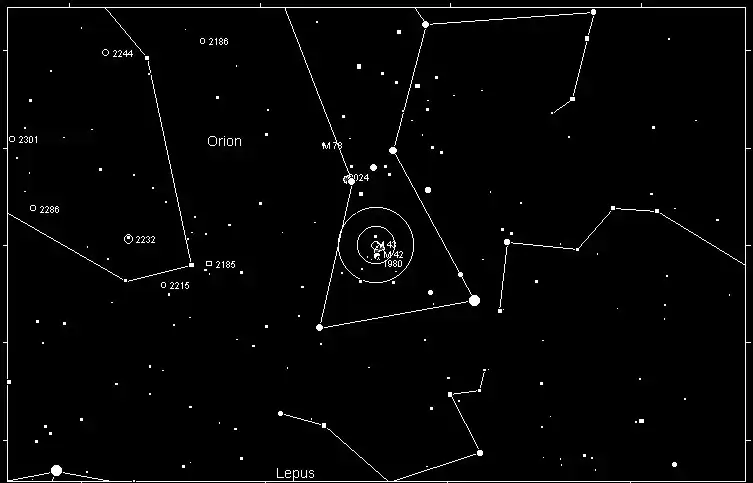Messier 43, also known as De Mairan's Nebula, is a bright, star-forming region located in the constellation Orion. It is part of the larger Orion Nebula complex, specifically situated to the north of the main nebula, Messier 42. M43 is a fascinating object in its own right, though often overshadowed by its more famous neighbor. The nebula is illuminated by a single young, hot star known as NU Orionis, which is responsible for the glowing gas cloud surrounding it. This region of space is a stellar nursery, where new stars are born from the collapsing clouds of gas and dust.
Magnitude
Messier 43 has an apparent magnitude of approximately +9.0, making it a relatively faint object that requires a small to medium-sized telescope to observe. While it is not visible to the naked eye, its close proximity to the Orion Nebula makes it easier to locate using a telescope.

Season of Prominence
M43 is best observed during the winter months in the Northern Hemisphere, from December through March. During this time, the constellation Orion is prominently visible in the night sky, making it an ideal season for observing Messier 43 and the surrounding nebulae.
Constellation
Messier 43 is located in the constellation Orion, one of the most recognizable and prominent constellations in the sky. Orion is known for its "belt" of three stars—Alnitak, Alnilam, and Mintaka—and its "sword," where M43 and the Orion Nebula are found.
How to Find Messier 43
To locate Messier 43, first find the constellation Orion in the night sky. The Orion Nebula, where M43 resides, is situated below Orion's Belt, in the "sword" of the constellation. When using a telescope, point it toward the middle star of Orion's sword, which is actually the Orion Nebula (M42). Once centered on M42, slightly move your telescope northward, and you should spot the smaller, circular glow of M43 just adjacent to the main nebula. M43 appears as a detached region of nebulosity, with a star at its center.

History
Messier 43 was first discovered by the French astronomer Jean-Jacques Dortous de Mairan in 1731. He described it as a "nebulous star" and noted its proximity to the larger Orion Nebula. Later, the nebula was included in Charles Messier's famous catalog of deep-sky objects, where it was designated as Messier 43. The inclusion of M43 in Messier's catalog helped solidify its place as an important object of study in the field of astronomy.
Over the years, M43 has been studied extensively, particularly in relation to the Orion Nebula's complex star-forming regions. Modern observations using advanced telescopes, such as the Hubble Space Telescope, have provided detailed images and insights into the processes occurring within this nebula, including the formation of new stars and the effects of stellar radiation on the surrounding gas clouds.
Conclusion
Messier 43 is a captivating object within the Orion constellation, offering amateur astronomers a glimpse into the dynamic processes of star formation. While it may not be as well-known as Messier 42, M43's close association with the Orion Nebula and its role in the stellar nursery make it a rewarding target for observation during the winter months. With a modest telescope and clear skies, M43 can be a delightful addition to any stargazing session.
